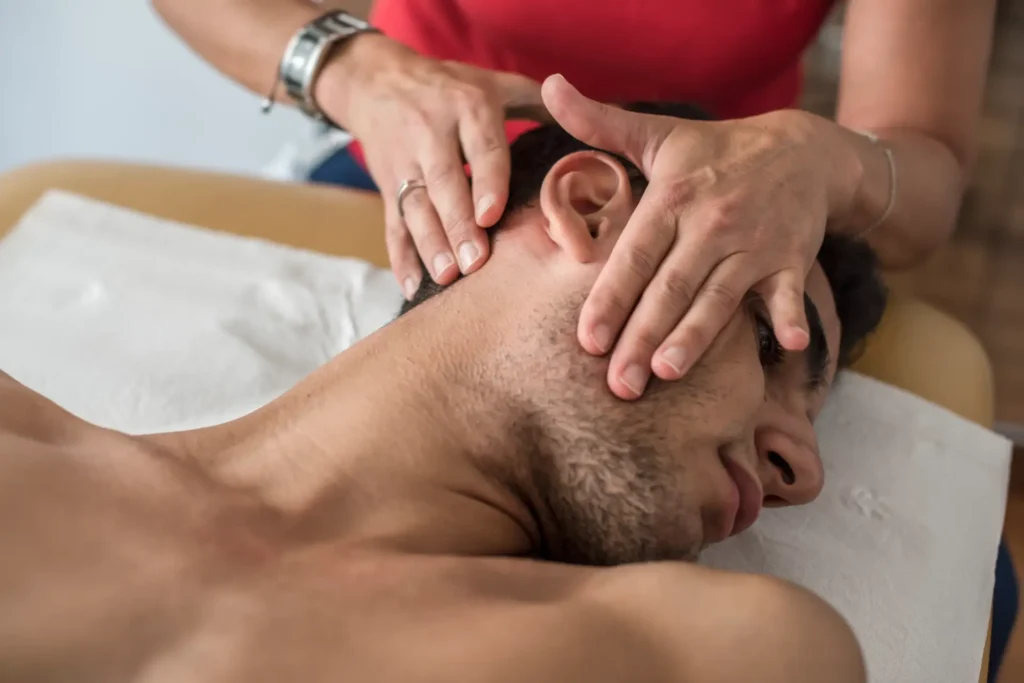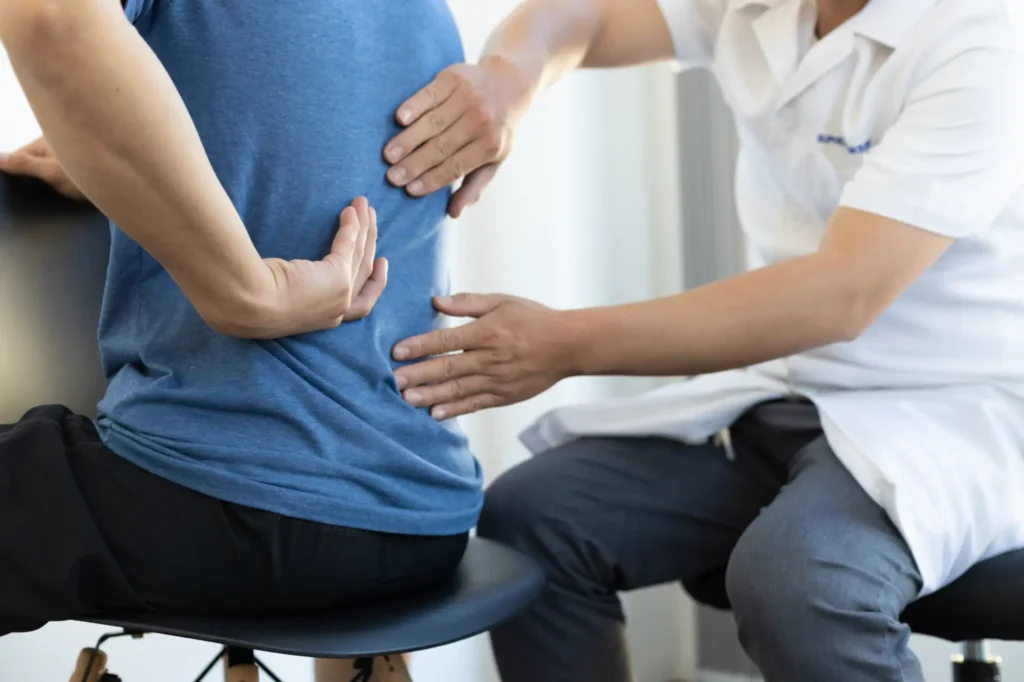Are you struggling with shoulder pain or recovering from surgery?
A consensus statement by the American Society of Shoulder and Elbow Therapists outlines a structured approach to shoulder rehabilitation after surgery. It emphasizes the gradual introduction of controlled movements to support healing based on the size of the tear, tissue quality, and the patient’s needs. This framework includes early immobilization, followed by progressive stages of range of motion, strengthening, and functional training. The goal is to ensure a safe and effective return to normal activities, such as sports or work.
Whether it’s a recent injury or post-op rehab, regaining full shoulder function can be challenging. But with the right approach and personalized care, you can get back to the activities you enjoy—pain-free. Here’s how targeted rehabilitation can help you along the way.
Assessment and Personalized Treatment Planning
Physical therapists conduct thorough evaluations of each patient’s condition and develop individualized treatment plans tailored to their specific needs and recovery goals. This personalized approach ensures that the rehabilitation program addresses the unique challenges of each patient’s shoulder surgery.
Pain Management and Early Mobility
In the early stages of recovery, physical therapists focus on managing post-operative pain and initiating gentle exercises to maintain joint mobility. They employ techniques such as:
- Ice therapy for pain relief
- Controlled movements to prevent stiffness
- Gentle massage to alleviate discomfort
Progressive Rehabilitation
As recovery progresses, physical therapists gradually introduce more advanced exercises and techniques:
- Range of Motion Exercises: Physical therapists guide patients through passive and active-assisted exercises to improve shoulder flexibility and prevent joint stiffness.
- Strengthening Exercises: Therapists implement a progressive strengthening program to rebuild muscle strength around the shoulder joint.
- Functional Training: In later stages, they incorporate exercises that mimic everyday activities to prepare patients for a return to normal life.
Post-Operative Shoulder Rehabilitation
Prestige Health and Wellness provides a structured program designed to support recovery following various types of shoulder surgeries, such as rotator cuff repair, shoulder replacement, and labral repair. Their post-operative rehabilitation program is tailored to each patient’s specific surgery and recovery needs, focusing on:
- Restoring strength, mobility, and function
- Minimizing pain and improving range of motion
- Preventing complications and re-injury
The program is divided into phases, progressing from early recovery to advanced rehabilitation:
- Early Recovery (Weeks 1-4): Passive range of motion exercises, postural training, and cold therapy.
- Intermediate Recovery (Weeks 4-8): Active-assisted range of motion, light resistance, and stretching exercises.
- Advanced Recovery (Weeks 8-12): Progressive strengthening, functional training, and balance work.
- Return to Activity (Weeks 12+): Sport-specific rehabilitation and functional range of motion restoration.
Post-Injury Shoulder Rehabilitation
After a shoulder injury, it’s important to address both the immediate symptoms and the underlying causes of pain or dysfunction.
At Prestige Health and Wellness, we offer a range of treatments to support healing and restore shoulder function. Chiropractic care plays a key role in realigning the shoulder and relieving pressure, setting the foundation for rehabilitation.
Chiropractic Care focuses on:
- Spinal Adjustments: Corrects misalignments to improve posture and reduce strain on the shoulder during recovery.
- Joint Mobilization: Employs gentle techniques to enhance shoulder joint mobility and alleviate stiffness, especially in early recovery stages
- Soft Tissue Therapy: Targets muscle imbalances and tension around the shoulder to reduce pain and promote healing
For non-surgical shoulder injuries, Prestige Health and Wellness offers various treatment options:
- Physical Therapy: Focused on strengthening muscles, increasing mobility, and correcting posture.
- Alternative Therapies: Including cold laser therapy, massage therapy, acupuncture, Graston Technique, ultrasound therapy, and electronic stimulation.
By combining these therapies, we offer a holistic and personalized approach to shoulder rehabilitation that addresses both the symptoms and the root causes of pain, ensuring a faster and more effective recovery.
Collaboration with Surgeons
Prestige Health and Wellness physical therapists work closely with surgeons to ensure that the rehabilitation process aligns with the specific surgery and recovery timeline. This collaborative approach optimizes the patient’s recovery journey.
By providing comprehensive care throughout the rehabilitation process, physical therapists at Prestige Health and Wellness play a vital role in helping patients regain strength, mobility, and function in their shoulders following surgery.
Rehabilitation Exercises for Shoulder Recovery
Rehabilitation exercises play a key role in restoring mobility and strength to the shoulder following surgery or injury. The goal is to gently ease the shoulder back into movement while promoting healing and preventing stiffness. In this section, we’ll explore a variety of exercises designed to help you gradually regain your shoulder’s range of motion and strengthen surrounding muscles.
Passive Range of Motion Exercises
- Pendulum Exercises: Using body weight to gently swing the arm in circular motions without engaging shoulder muscles

- Shoulder Forward Elevation (Assisted): Using the unaffected arm or a stick to lift the operated arm overhead within a comfortable range.
Active-Assisted Range of Motion
- Shoulder Forward Elevation (Active): Raising the arm upward toward the ceiling while keeping elbows straight.
- Shoulder Abduction: Lifting the arm out to the side without shrugging or tilting the trunk.
Isometric Strengthening Exercises
- Shoulder Extension (Isometric): Pressing arms backward against a wall while standing straight.
- Shoulder External and Internal Rotation (Isometric): Pushing the back of the hand or palm into a wall for rotation exercises.
Scapular Strengthening
- Shrugs, Depression, Retraction, and Protraction: To improve scapular muscle function, especially during early recovery when the arm is in a sling.
These exercises are performed progressively based on recovery phases, starting with passive movements and advancing to active and strengthening exercises as healing progresses.
Alternative Therapies
- Acupuncture: Used to address energy imbalances and provide pain relief.
- Massage Therapy: Helps relieve muscle tension and reduce pain in the shoulder area.
By combining these various treatment options, Prestige Health and Wellness creates personalized rehabilitation plans that address each patient’s unique needs, ensuring a comprehensive approach to shoulder recovery and long-term health.
Ready to regain full shoulder function?
We offer comprehensive shoulder rehabilitation services tailored to your unique needs, whether you’re recovering from surgery or a post-injury condition.
At Prestige Health and Wellness the following specialists can help with this treatment: Physical Therapists and Occupational Therapists. We accept most major insurance providers – your treatment may be covered depending on your condition and plan. For more information please view our Frequently Asked Questions (FAQ). Book a personalized assessment today to learn if this is the best treatment option for you.
If you are ready for the next step, book your appointment online or call (917) 694-1565 to receive personalized treatment and help restore strength and mobility and reduce pain.
Visit us at one of our convenient locations across NYC: Financial District, Hudson Yards, Chelsea, or Nomad. Our expert therapists will guide you through every phase of recovery, whether post-op or post-injury.
Sources
Cleveland Clinic. (2022, January 10). Stretches and exercises for rotator cuff tears. https://health.clevelandclinic.org/rotator-cuff-tear-exercises-stretches
Parel, I., Candoli, V., Filippi, M. V., Padolino, A., Merolla, G., Sanniti, S., Galassi, R., Paladini, P., & Cutti, A. G. (2023). Shoulder rehabilitation exercises with kinematic biofeedback after arthroscopic rotator cuff repair: Protocol for a new integrated rehabilitation program. JMIR Research Protocols, 12, e35757. https://doi.org/10.2196/35757
Thigpen, C. A., Shaffer, M. A., Gaunt, B. W., Leggin, B. G., Williams, G. R., & Wilcox, R. B., 3rd. (2016). The American Society of Shoulder and Elbow Therapists’ consensus statement on rehabilitation following arthroscopic rotator cuff repair. Journal of Shoulder and Elbow Surgery, 25(4), 521–535. https://doi.org/10.1016/j.jse.2015.12.018



